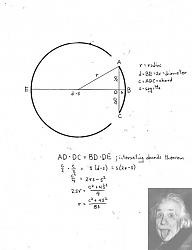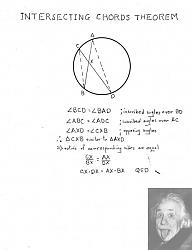In geometry there is a little known theorem called the Intersecting Chords Theorem. It states that, if two chords intersect inside a circle, the product of the two sections of one chord is equal to the product of the two lengths of the other chord.
The utility of the Intersecting Chords Theorem isn't immediately obvious. This example problem demonstrates at least one use...
In the accompanying diagram, you're given only the partial arc of a circle ABC and must find the radius of the circle and the center on which it is drawn. The procedure for doing this is:
Draw the chord ADC.
Construct the perpendicular bisector, BDE, of the chord ADC. The diagram shows it extended to the opposite side of the circle (point E) but this point is not yet determined so, in practice, the bisector would be extended past it. No matter, the location of point E will be known once the radius is calculated and the complete circle is reconstructed. Remember that the perpendicular bisector of ANY chord passes through the center of the circle; that fact will be used later.
We now have two intersecting chords - ADC and BDE - so we can apply the Intersecting Chords Theorem. The algebra to do this is shown on the diagram. An equation for the radius is found that depends only on the lengths of the chord, ADC, and the sagitta, BD, both of which can be measured from the arc directly.
Once the radius length is calculated using the derived expression, an arc of that length swung from point A, B or C, will intersect the bisector at the center of the circle.



 LinkBack URL
LinkBack URL About LinkBacks
About LinkBacks


 Reply With Quote
Reply With Quote




Bookmarks